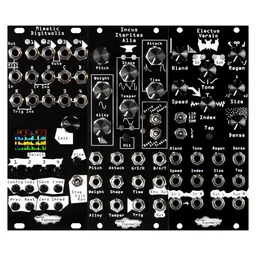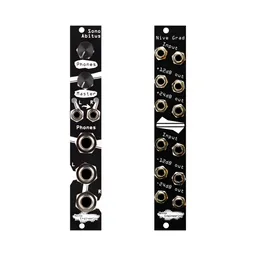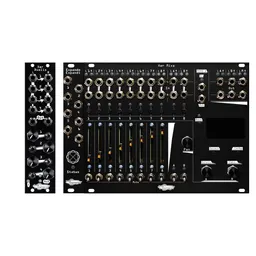
Jumping into Eurorack can be daunting -- aside from deciding on your first few modules, picking out a case can be a challenge of its own. Today, we’ll talk about a few concepts that will help get you started on your modular journey and next week, we’ll pick out our first modules.
Cases: like a house for your synth
Just like cats, modules like to sit in boxes. There are quite a few cases on the market, so picking one generally comes down to a few key factors: size, portability, and power.
Size
Let’s start with that first one, size. Your case will have a certain amount of space that modules can fit in, measured in HP (horizontal pitch, or how wide it is) and 3u rows (how tall it is). Modules will be measured in HP, so, for instance, if you want to add a Manis Iteritas to your system, you’ll need 10 HP free.
Figuring out how much space you need can be a bit difficult. Generally, you’ll want to get something that’s a little bit bigger than you think you need: you always discover new things you want to be able to do, especially starting out, so having room to grow can be important. I generally recommend people get a case that’s at least 3U x 84 HP, or even something like the 62 HP Intellijel Palette if you’re planning a focused and portable system. If possible, something like 6U x 84 HP or 6U x 104 HP will give you enough space to create a well-equipped system, and might be as big as you want your system to ever be.
For reference, at NE, we all have different cases: Kris and Stephen use Submodular cases (and those are what we use to demo modules at shows, too). They are extremely lightweight and are super durable. They fit in the overhead bins on planes. You can even strap two together and they still fit up there (but talk about heavy).
I, Markus, use a couple of Doepfer monster cases for my system: I like them as they’re big, stackable, and have lids for when my system isn’t in use or needs to be moved.

Norman uses a mix of cases for different things, rearranging layouts as he goes and wants to try new things.
Ankoor uses a custom laser-cut case for his melodic system from null-la. And sitting around NE, we have a load of cases that we threw together out of scrap wood. They are not the prettiest, but they are functional. That’s right,if you have the skills, DIYing a case might be the way to go. It’s a process, though, and requires a bit of knowledge and skill, so it may not be the best choice if you’re just starting out.
Portability
Portability is something that you should also take into consideration: do you envision your system staying in the studio, or going out to events and shows? My system stays in my studio, so making it a manageable size wasn’t a concern for me. However, if you’re planning on performing, or even jamming with friends, having a case that’s small and has a handle or bag may be a key feature. While you’re considering that, do you anticipate wanting to travel with the case patched? Some cases come with lids that make that possible; some have lids that fit too tightly to accommodate patch cables.
We’ll go over power in more detail in this next section, but some cases have power built-in, and some require getting power yourself, either in the form of a power module or installing a PSU and busboards in the case yourself. If you’re starting out and haven’t dealt with Eurorack power before, getting a case with power built-in is a great choice. Let’s talk more about that!
Power
Some cases have power built-in, and some require getting power yourself, either in the form of a power module or installing a PSU and busboards in the case yourself. If you’re starting out and haven’t dealt with Eurorack power before, getting a case with power built-in is a great choice.
Power is one of the most confusing things to figure out when you’re starting out in Eurorack. Eurorack modules need power to do, well, anything, and getting the proper supply for your system is a key step in your journey.
Eurorack power is split into three sections: +12v, -12v, and +5v, often referred to as “rails.” A power supply creates those three types of power, and distributes it to your modules via busboards. Your module will generally come with a power cable, and you plug your new module into the busboard, screw it in, and turn it on. (Read more about plugging in a module for the first time here.)
However, a power supply can only output a finite amount of each type of power. It’s measured in milliamps, often abbreviated mA. It’s a good idea to plan out a rough idea of what modules you’ll want in your system and add up how much power they take on each rail. A module’s user manual should list how much of each type of power it consumes, but Modulargrid is a really great resource for doing this. Then, when looking at different Eurorack cases, you can see if its power supply can power all of the modules you want to put in it. Power supplies need to output more than your modules take in on each of the three rails.
What about modules?
Now that you’ve got an idea of what you need to think about when picking a case, how do we decide what to fill it with? Come back next week when we’ll discuss picking out your first modules and creating a system that’s perfect for you!






